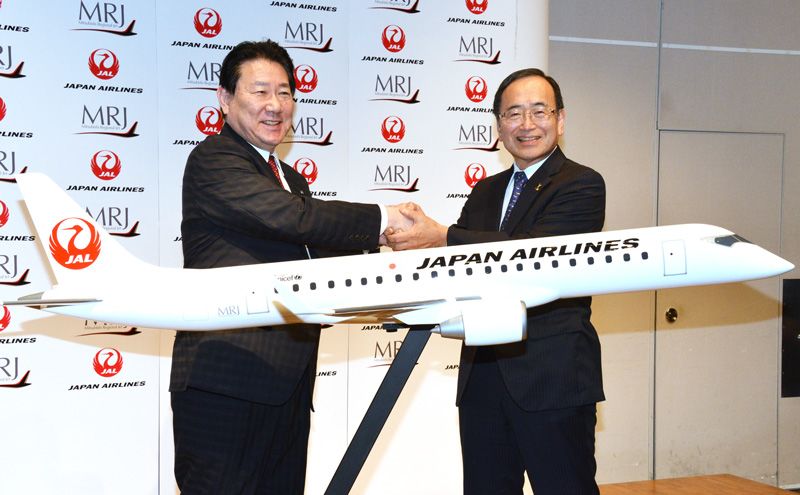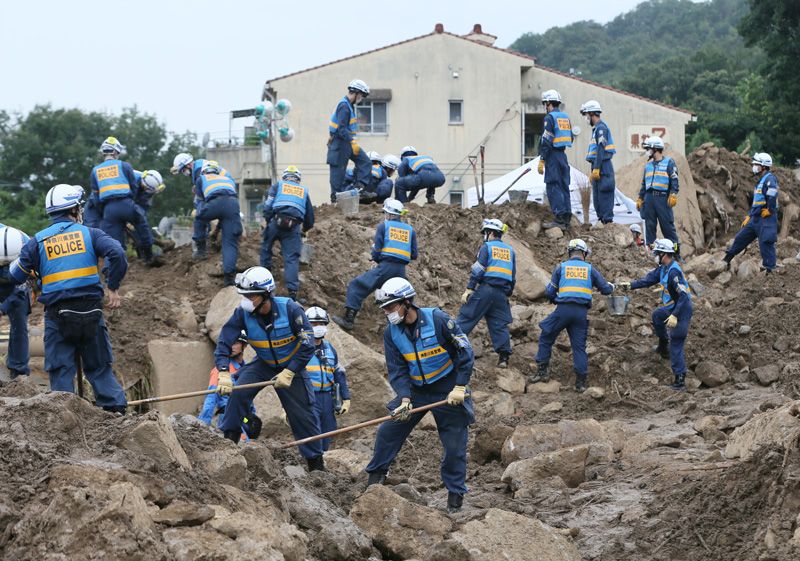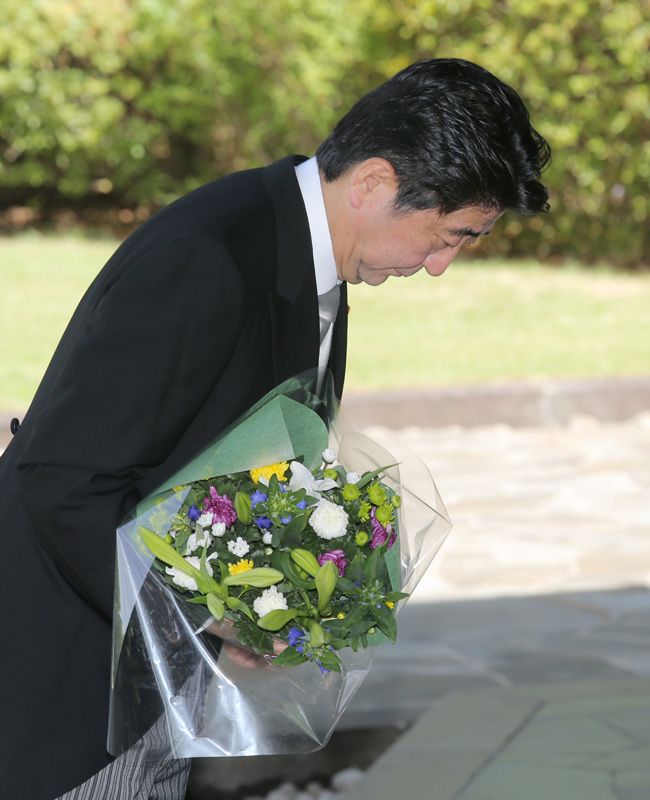Timeline for August 2014
Politics Economy Science Technology Society- English
- 日本語
- 简体字
- 繁體字
- Français
- Español
- العربية
- Русский
3
 Japan Airlines has also ordered MRJ planes. Here JAL President Ueki Yoshiharu (left) shakes hands with Mitsubishi Aircraft Corporation’s Chairman Egawa Hideo (right). © Jiji
Japan Airlines has also ordered MRJ planes. Here JAL President Ueki Yoshiharu (left) shakes hands with Mitsubishi Aircraft Corporation’s Chairman Egawa Hideo (right). © Jiji
Mitsubishi Heavy Industries unveils a new test facility and prototype for the Mitsubishi Regional Jet at its Komaki Minami plant in Toyoyama, Aichi Prefecture. The MRJ will be Japan’s first domestically built passenger plane since the YS-11 around 50 years ago. The first model is scheduled to be delivered to All Nippon Airways in April 2017.
5
Sasai Yoshiki, deputy director of the Riken Center for Developmental Biology in Kobe, commits suicide at his research building. Sasai had been a coauthor of two papers on STAP cells published in Nature and subsequently retracted due to incidences of scientific misconduct, as well as a mentor to their lead author, Obokata Haruko. When Riken’s Research Paper Investigative Committee confirmed misconduct in April, it judged that Sasai bore “heavy responsibility.”
6
The Hiroshima Peace Memorial Ceremony is held in the Peace Memorial Park to commemorate 69 years since the world’s first atomic bomb was dropped on the city. Around 45,000 survivors and relatives attend, along with Prime Minister Abe Shinzō and representatives from 68 countries and the European Union. At Nagasaki’s corresponding Peace Memorial Ceremony on August 9, Mayor Taue Tomihisa raises concern about the Abe government’s reinterpretation of the Constitution to allow for collective self-defense. US ambassador Caroline Kennedy attends both ceremonies, making her first visit to Hiroshima since becoming ambassador in November 2013.
Thai police discover nine children apparently aged between one month and two years old in a Bangkok condominium. Their father is Shigeta Mitsutoki, a 24-year-old Japanese businessman; surrogate mothers bore all the children. Further investigation reveals that Shigeta has a total of 16 children by surrogate mothers. Thai police are seeking to discover whether there has been any infringement of child protection laws.
9–10
Japanese Foreign Minister Kishida Fumio meets with the South Korean and Chinese foreign ministers at the Association of Southeast Asian Nations Regional Forum in Naypidaw, Myanmar. His August 9 meeting with Yun Byung-se of South Korea is the first between the two countries’ foreign ministers since September 2013. Meanwhile his August 10 meeting with Wang Yi of China is the first between the two countries’ foreign ministers since September 2012, before the current Abe administration took office. In both cases, long-standing questions such as perceptions of history and territorial issues are an obstacle to agreement.
13
Mutō Akira, deputy director-general of the Ministry of Foreign Affairs European Affairs Bureau, summons Sergei Zhyosky, the Russian acting ambassador to Japan, following the beginning of Russian military exercises on August 12 in the Kuril Islands, including the disputed Northern Territories, and reaffirms that the four islands are part of Japan.
15
At a Tokyo ceremony for the repose of Japan’s World War II dead, attended by Emperor Akihito and Empress Michiko, Prime Minister Abe says Japan will “make every effort to contribute to eternal world peace.” However, as with last year’s ceremony held on the anniversary of the end of the war, he makes no mention of Japan’s role as aggressor in the conflict.
Internal Affairs Minister Shindō Yoshitaka, National Public Safety Commission Chairman Furuya Keiji, and Administrative Reform Minister Inada Tomomi visit Yasukuni Shrine. Instead of making his own visit, Prime Minister Abe makes a monetary donation to Yasukuni Shrine through a representative for the second successive year and goes to offer flowers at Chidorigafuchi National Cemetery. Chinese and Korean reaction to the ministers’ Yasukuni visit is muted compared with last year.
16
The Japanese embassy in Syria receives a report that a Japanese national is being held by the terrorist group Daesh (Islamic State) in the north of the country. The man is later identified as Yukawa Haruna, head of a newly formed security firm, who arrived in Syria in July 2014.
18
The Ministry of Defense begins a boring survey off the coast of the city of Nago in Okinawa as part of its efforts to relocate US Marine Corps Air Station Futenma in Ginowan to Henoko in Nago. It is the first such survey undertaken since the move was proposed in 1996. The MOD plans to complete the survey in November 2014 and start landfill operations before April 2015.
20
Landslides caused by torrential rain bury houses in the Asaminami and Asakita districts of Hiroshima, killing 72 people and leaving 2 missing. A total of 217.5 millimeters of rain falls in three hours in the Asakita district, the heaviest rainfall ever for the area, and evacuation advisories go out to more than 150,000 residents. The disaster prompts further discussion of the need to more proactively designate certain areas as hazard zones.
 Police search for survivors in the Asaminami district. © Jiji
Police search for survivors in the Asaminami district. © Jiji
Chinese antitrust regulators find 12 Japanese auto parts and bearings manufacturers guilty of price fixing and impose fines on 10 of them totaling approximately ¥20 billion. Sumitomo Electric Industries and the Yazaki Corporation receive the largest fines.
The Japan National Tourist Organization announces that 1.27 million foreign visitors came to Japan in July, up 26.6% compared with July 2013, and a new monthly record. More than 7.5 million foreign tourists have visited so far in 2014, which is also a record for January to July. The weakening yen, increased international flights to Haneda Airport, and easing of visa requirements for some Southeast Asian citizens are thought to have played their part.
22
Russia bans selected Japanese citizens from entering the country. The same day, Russian authorities stop the whaling ship Shōnan Maru in Russian waters in the Sea of Okhotsk, questioning the captain and crew. As Japan-Russia relations continue to deteriorate since the onset of the Ukraine crisis, President Vladimir Putin’s autumn visit to Japan looks increasingly doubtful.
24
Host Japan loses 3-0 to Brazil in the final match of the 2014 FIVB World Grand Prix for volleyball to finish in second place overall.
25
Osaka Tōin beats Mie 4–3 to take the 2014 summer Kōshien high school baseball pennant. It is the Osaka school’s fourth summer championship, and fifth overall, including one spring Kōshien pennant. Ace pitcher Fukushima Kōsuke pitches his second complete game in two days, following Osaka Tōin’s 15–9 slugfest victory over Tsuruga Kehi on August 24.
The government announces it will release testimony given to an investigative committee by Yoshida Masao, plant manager at the Fukushima Daiichi Nuclear Power Station during the 2011 meltdown crisis. It reversed its decision not to release the testimony, which had been in accordance with Yoshida’s wishes before he died in July 2013, after some parts were leaked to the media.
27
Riken announces in an interim report that as yet it has been unable to recreate STAP cells using the methods described in January’s Nature papers. The research institute’s efforts will continue until the end of March 2015, while team leader Obokata Haruko will conduct separate studies until the end of November 2014.
Chief Cabinet Secretary Suga Yoshihide confirms that Prime Minister Abe sent a message of support to an April ceremony at the Wakayama temple Kōyasan Okunoin honoring those Japanese convicted of war crimes after World War II. Suga says that the message was sent in a private capacity.
30
Indian Prime Minister Narendra Modi begins a five-day visit to Japan. Modi and Abe enjoy a close personal relationship and are expected to bolster bilateral economic and security ties.
tourism RIKEN Russia Fukushima Northern Territories Thailand Yasukuni Shrine Nagasaki Hiroshima atomic bomb STAP Henoko
